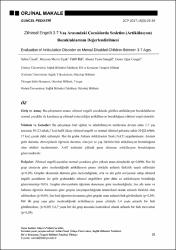Zihinsel Engelli 3-7 Yaş Arasındaki Çocuklarda Sesletim (Artikülasyon) Bozukluklarının Değerlendirilmesi
Özet
Giriş ve Amaç: Bu çalışmanın amacı; zihinsel engelli çocuklarda görülen artikülasyon bozukluklarını
normal çocuklar ile karşılaştırıp zihinsel yetersizliğin artikülasyon bozukluğuna etkisini tespit etmektir.
Yöntem ve Gereçler: Bu çalışmaya özel eğitim ve rehabilitasyon merkezine devam eden 3-7 yaş
arasında 30 (23 erkek,7 kız) hafif düzey zihinsel engelli ve normal zihinsel gelişime sahip 30 (13 erkek,
17 kız) çocuk dahil edilmiştir. Her iki gruba Ankara Artikülaston Testi (AAT) uygulanmıştır. Ailenin
gelir durumu, ebeveynlerin öğrenim durumu, cinsiyet ve yaş faktörlerinin artikülasyon bozukluğuna
olan etkileri incelenmiştir. AAT testinden yüksek puan alınması artikülasyon bozukluğunu
göstermektedir.
Bulgular: Zihinsel engelli çocuklar normal çocuklara göre yüksek puan almışlardır (p=0,000). Her iki
grup cinsiyete göre incelendiğinde artikülasyon puanı yönüyle anlamlı farklılık tespit edilmiştir
(p˂0,05). Gruplar ekonomik duruma göre incelendiğinde, orta ve altı gelir seviyesine sahip zihinsel
engelli çocukların üst gelir grubundaki zihinsel engellilere göre daha az artikülasyon bozukluğu
göstermiştir(p˂0,05). Gruplar ebeveynlerin öğrenim durumuna göre incelendiğinde, lise altı anne ve
babanın öğrenim durumuna göre gruplar karşılaştırıldığında istatistiksel olarak anlamlı farklılık elde
edilmezken (p>0,05), lise üstü öğrenim durumuna göre gruplar arası anlamlı fark görülmüştür (p˂0,05).
Her iki grup yaşa göre incelendiğinde artikülasyon puanı yönüyle 3,4 yaşta anlamlı bir fark
görülmezken, (p>0,05) 5,6,7 yaşta her iki grup arasında istatistiksel olarak anlamlı bir fark mevcuttur
(p˂0,05). Tartışma ve Sonuç: Hafif derecede zihinsel engeli olan çocuklardaki artikülasyon bozukluğu, normal
gelişim gösteren çocuklara göre daha fazla görülmektedir. Introduction: The aim of this thesis is to make a scientific research about the effects of mental
deficiency on articulation disorders in mentally retarded children by comparing those children to the
regular ones and provide the findings.
Methods: The sample group of the research consists of 30 children (23 males and 7 females) with mild
mental retardation whose ages range from 3 to 7 years old and 30 children (13males and 17 females)
with regular mental development. The participants receive education in a special education and
rehabilitation centre located. Both of the sample groups have received Ankara Articulation Test (AAT)
developed by Ege, Acarlar and Turan (2004). The effects of family income, educational background of
the family, gender and age factors on articulation disorders have been examined.Getting a hıgh score
from AAT test shows that is articulation disorder.
Results: Mentally retarded children got higher scores than the children with normal development
(p=0,000). When these two groups analysed in terms of gender, it is identified that there is a huge
difference between the genders in respect to articulation sores (p˂0,05). When the groups analysed
according to their economic situation, mentally retarded children coming from low and lower-middle
income families have less articulation problems than those who are in the high- income group (p˂0,05).
When the groups analysed according to educational backgrounds of the parents, there is no statistically
striking difference (p>0,05), in lower education than high school while there is a noticeable difference
in higher education than high school. (p˂0,05).When the groups analysed according to the age
factor,articulation points with no meaningful difference in the direction 3-4 years (p>0,05) but
significant difference was observed between the two groups in age 5-6-7 (p˂0,05).
Discussion and Conclusion: Children with mild mental disabilities has articulation disorder more than
the normal children.

















